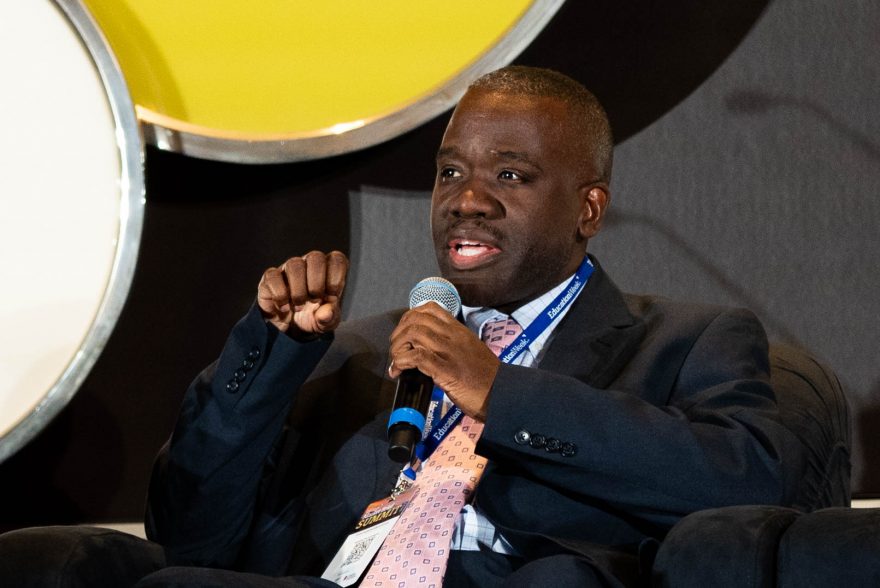How the Science of Reading Is Impacting One Big District’s Purchasing Decisions

Phoenix
Whether or not a vendor is aligned to the science of reading is not just a priority when it comes to working with the Wake County Schools in North Carolina — it is often make-or-break.
The process of training teachers on how to adhere to the growing approach to teaching reading is long, said Shawn Johnson, the district’s director of Prek-12 literacy. But it’s one the 160,000-student district is fully committed to.
With that comes a shift in thinking about the resources and curriculum products the district buys to support its 120 elementary schools.
“Now we’re looking at everything that we purchase through that lens,” he said.
Johnson spoke about how new laws requiring schools to follow the “science of reading” are affecting districts’ instructional purchases, professional development, and assessments on day one of EdWeek Market Brief’s annual summit, a gathering of representatives from education companies held this year in Phoenix.
Such legislation has swept the country in recent years, as more than 30 states have approved policies around the science of reading, which emphasizes an evidence-based approach to instruction and teacher training.
The change represents a broad shift away from theories that learning to read is a natural process or a series of strategic guesses young children make based on context. The new emphasis is on research that shows teaching children to decode language through systematic phonics is the most reliable way to ensure they learn how to read.
For education companies, aligning their products and services to the new state mandates has become increasingly important, as district officials hold products to those standards.
But the approach has also met some pushback, reopening decades-old debates and leading some districts to call on legislators to allocate more resources to support and train educators through the significant transition.
Wake County hasn’t faced much pushback from the community since moving toward the science of learning around three years ago, before it was required by state law, Johnson said. But it has been a big undertaking for the large district.
The training — state-mandated to be provided by Lexia LETRS — takes two years to complete, he said. The district’s core group of educators will finish their program in the spring of 2024.
Finding time to build that into teachers’ hectic schedules was the biggest challenge, he said. That’s especially true since the district prioritized not asking teachers to give up their evenings and weekends for the professional development.
Getting Implementation Right
Johnson has also worked to build the capacity to support educators going through the PD, both by training administrators and purchasing new resources. Johnson said district leaders quickly realized they needed to know more about teaching theories that the science of reading supports.
“Once we embarked on this learning, we recognized that we needed both the word-recognition component as well as the language-recognition component and language comprehension within our instruction,” he said. “So we’ve made the necessary adjustments and procured resources to align with the science of reading.”
If there isn’t an alignment to the science of reading, then it’s really not advantageous to us to even consider the resource.Shawn Johnson, director of Prek-12 literacy, Wake County Public Schools
So far the district hasn’t gathered any reliable data on how the shift has affected student outcomes. It will take about 3-5 years of implementation, Johnson said, before it’s scientifically sound to do that kind of analysis. But they will soon begin looking at student achievement trends over time.
And the district is also planning to go further — to pilot a science of reading training with the state for secondary teachers.
Johnson sees this interest in a more scientific approach to reading as a long-term move in education. Given the amount of attention it’s received from lawmakers, he said he expects the science of reading to soon be tied to teacher licensing requirements.
“We’re always trying to find that moving target and to ensure that we are in line with what best practices are in research,” Johnson said of the education field. “So I think that the science of reading is something that’s come about as a result of that.”
For education companies, he recommends doing the work to align their products and services with district requirements, starting with familiarizing themselves with Scarborough’s Reading Rope and the Simple View of Reading.
“If there isn’t an alignment to the science of reading, then it’s really not advantageous to us to even consider the resource,” Johnson said. “It’s the expectation. We know that this is best practice. We’ve already built some of our instructional practices around the science of reading.”
“It really benefits us to make sure that anything that we procure moving forward has that alignment.”
Photo of the Wake County Schools Director of Prek-12 Literacy Shawn Johnson at the EdWeek Market Brief Summit by Kaylee Domzalski/Education Week.
Follow EdWeek Market Brief on Twitter @EdMarketBrief or connect with us on LinkedIn.
See also:
- Education Company Executives Weigh In: Trends to Watch for the 2023-24 School Year
- Districts Are Ramping Up Standards for ELL Materials. Here’s How to Meet Rising Expectations
- How One State’s Reading Overhaul Will Affect Schools and Curriculum Providers
- From the archives: Texas Is Revamping Reading Instruction, With Big Implications for the Market
